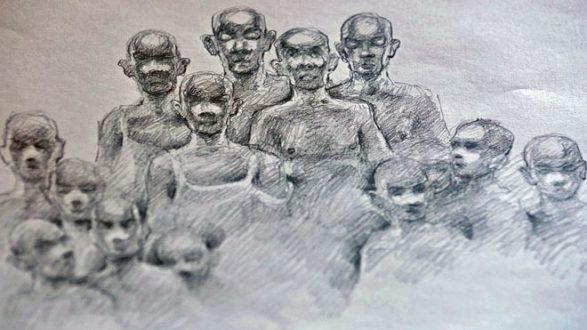Drawing the horror of a Syrian detention centre
A Syrian artist who was accused of being an opposition activist and tortured in a detention centre has drawn pictures of his experiences – and described how he became numb to death, as dead bodies were piled up in the cell he shared with dozens of other naked prisoners. Some readers will find his account disturbing.
It is dark, cold and there is an overpowering smell of death and disease. Nearly 70 men are cramped in a room measuring 3m by 4m – one of hundreds of cells inside Syria’s notorious detention centres. The men are skinny, naked and shivering with fear. They have no dignity. Day in day out, death and fear surrounds them till they accept it as normal.
“They used to bring the bodies from the basement and pile them in front of us,” says the artist, whom I will call Sami.
“Every day there would be about eight new bodies. After a week I managed to get closer and count the number written on a body’s forehead. It was 5,530 – and after a month and a half, the number on another body was 5,870.
“I got used to it. The first night I saw a dead body and smelled it, I felt so sick and sad I couldn’t sleep. But later on we were eating while a dead body was next to us. I remember leaning on a dead body and thinking, ‘When are they going to remove it so I can have more space?'”
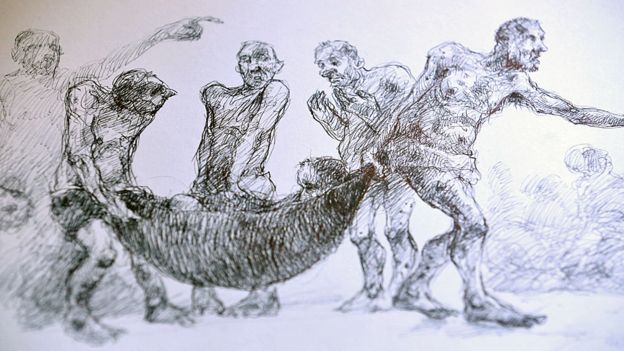
Sami was arrested twice in the years after the Syrian uprising in 2011. His crime was coming from a town, a religious group and a family that had revolted against President Bashar al-Assad.
“I had long curly hair when I was detained for first time. This modern look was a sign for the government that I belong to the co-ordination committees that organised protests. The security officer dragged me by my hair and told his boss, ‘We’ve got one of the co-ordinators sir,'” Sami told me.
“I was picked up on my way to work, my head was covered and I was put in a car. I don’t know where they took me but they put me in a hall while my hands were tied with wires. They started beating me up madly. Then I reached the detention centre. I was bleeding, bones broken, ears damaged so that I couldn’t hear properly. The place was like Dante’s inferno. You are constantly tortured and you hear the cries of people being tortured. I was kept in the basement maybe seven storeys down.”
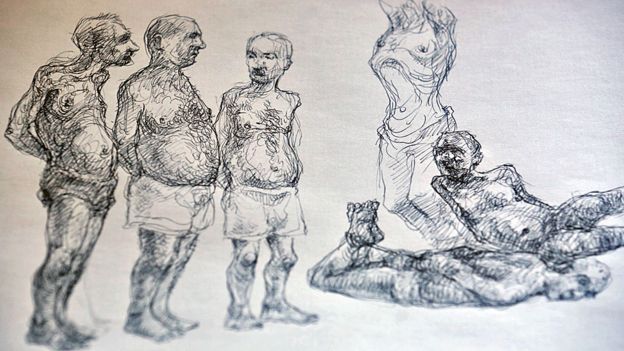
Sami’s second period of detention was even worse. He spent three months in a detention cell before being referred to terrorism court, set up under an anti-terrorism law issued in 2012. He was accused of inciting terrorism and threatening state security. He was imprisoned awaiting trial for nine months.
Eventually, Sami was able to bribe his way out. He paid nearly $15,000 to get out of prison and later out of the country.
“Your family pays money to find a key person inside the detention cells who can help keep you alive,” he says. “Money is paid so that prisoners are transferred from a detention cell to prison, where they are referred to the terrorism court.”
His wife, Fidaa (not her real name) had the difficult job of finding the right person to bribe. It took $3,000 simply to find out where Sami was being held.
Then she had to pay money to ensure that Sami would not continue to be tortured. One of the people who promised to help ensure Sami’s release disappeared after a week, forcing her to look for another contact who might help.
Then one day she got a call from a relative saying that Sami was in fact being held somewhere else.
“That moment I was terrified,” she says. “I felt I had lost track of him and lost him forever. I spent the next 18 days in a terrified state until I managed to locate him.”
Then more payments were required to get him transferred to a terrorism court. At that point she was taken to see him by her contacts.
“They called his name,” she says.
“Someone appeared in the room. I couldn’t believe my eyes. It was a different person – almost a third of his size. When he ran towards me I realised it was him.
“He came to see me through the viewing barrier, he wanted to kiss me and touch my hands. I didn’t know what to do, cry or laugh.”
But it took nine months. During that time Fidaa made 38 dangerous journeys to Adra prison to see him.
“The road to the prison was horrifying,” she says. “The whole area was brutally destroyed. You want to cry and you can’t – it was dead body of a city. The car was driving so fast. We were told there were snipers. So you go to visit a prisoner, and you might end being killed.”
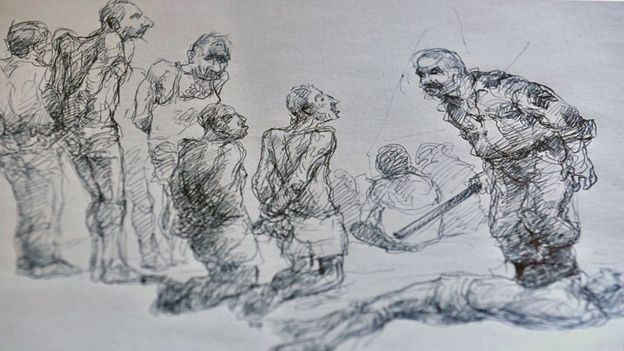
Sami has lost 40 members of his family, all killed by the regime. He moved home twice inside Syria looking for a safe place to live with his wife and daughter. His own house and another belonging to his family were burned down by government forces in the Damascus suburb he comes from.
For nearly two years before his second period in detention he went everywhere he needed to go in Damascus on foot, rather than using a car, to avoid being picked up at checkpoints.
The Syrian government says it is fighting terrorism, but Sami says none of the people he met in detention were terrorists.
“I didn’t see any Islamists or jihadists or radicals in prison. I just saw ordinary Syrians,” he says. “Needless to say, almost everyone in prison is Sunni.”
Some prisoners were treated worse than others, he says.
“They look at you and decide what treatment you get. Men from the city with money are treated differently than those coming from poor and rural areas. The more money and connections you have, the less tortured you are.”
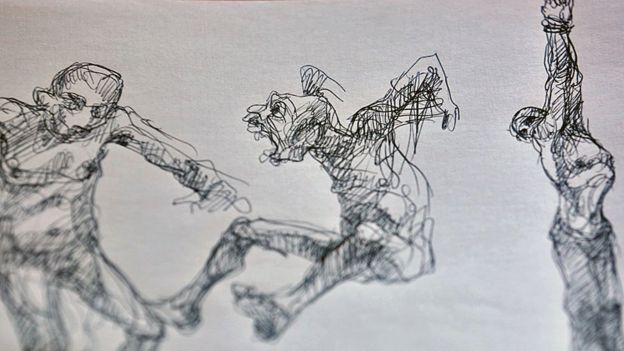
Many have argued that this sort of treatment drives poor young Sunnis into the arms of Islamist radicals – though Sami says he personally never encountered any Islamists in Syria.
The threat to him, he says, came exclusively from the Assad government, and it was the government that drove him eventually to leave the country.
He and his wife and daughter are now in Europe, where Sami is recovering from his ordeal.
“I try to get over my fears by drawing or playing music,” he says. “This is the only way I can survive.”

